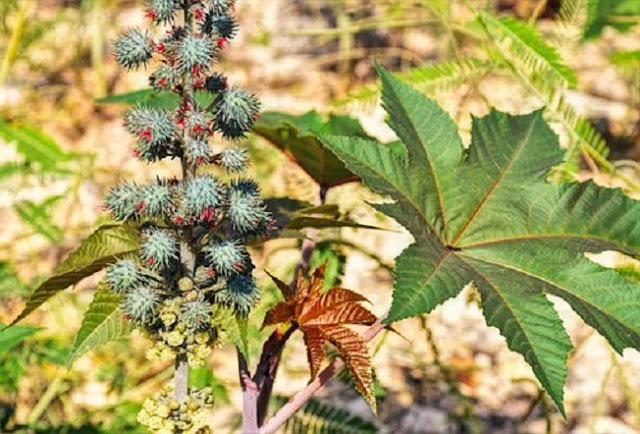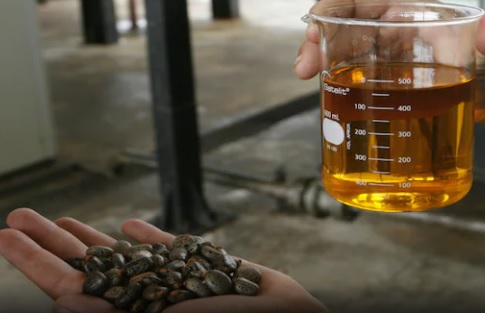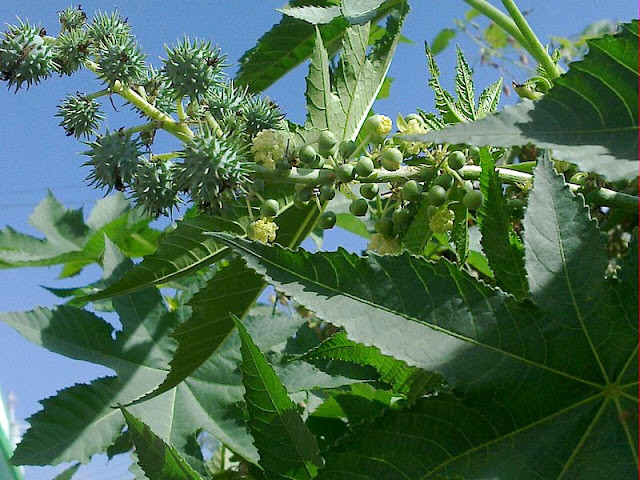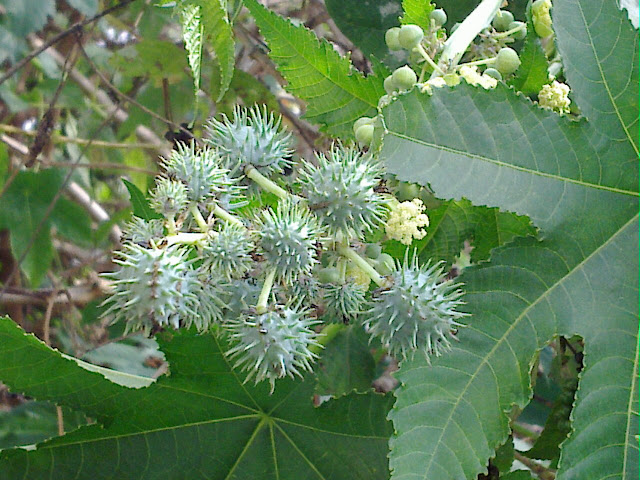Cultivation of Castor; A Complete Information Guide
Introduction;
Castor (Ricinus communis L.) belongs to the Euphorbiaceae family It is a tall glabrous annual or perennial shrub or a small tree growing to a height of 3 to 8 meters. It is cross-pollinated crop
India occupies the first position in the world in regards to acreage (5.4 lakh hectares) and production (2.6 lakh tonnes) with the productivity of 19.77 q/ha India contributes about 28 % of the world’s acreage and 36 % of total output.
Uses of Castor oil ;
9) Castor oil is used for many veterinary uses. It is used externally as an emollient. It is also used as a soothing medium when dropped into the eyes of animals after the removal of foreign bodies.
Medicinal Importance of Castor Oil;
1) A Strong Laxative; Castor oil increases the movement of the muscles and is commonly used to relieve temporary constipation.
2) A Natural Moisturizer; Castor oil can be used to moisturize the skin and help in preventing water loss through the outer layer of the skin. Castor oil often added to products like lotions, makeup, and cleansers.
3) Helps in Wound Healing; Application of castor oil to wounds creates a moist environment that promotes healing and prevents sores from drying out.
4) A Good Anti-Inflammatory Effects; The pain-reducing and anti-inflammatory qualities of castor oil is helpful to those with an inflammatory disease such as rheumatoid arthritis or psoriasis
5) Reduces Acne
6) Keeps Your Hair and Scalp Healthy; Castor oil helps in lubricating the hair shaft, increasing flexibility and decreasing the chance of breakage
6) Fights Fungus; Very useful in dental in plaque overgrowth, gum infections, and root canal infections.
Climatic Requirements for Castor Cultivation ;
1) The castor plant grows throughout India up to an elevation of 2500 meters.
Soil Requirement for castor cultivation;
1) Castor can be raised practically on any type of soil, but as with many plants, a well-drained loam will produce the optimum yield.
Important Varieties of Castor ;
Characteristics of important varieties of castor with their suitability for different areas are given below:
|
Varieties |
||||
|
Variety |
Yield potential (kg/ha) |
Oil content (%) |
Recommended states/regions situations |
Salient features/ traits |
|
Jwala (48-1) |
1000 (R) 1800 (I) |
50 |
All castor growing areas under both rainfed and irrigated |
Resistant to Fusarium wilt; tolerant to Botrytis, salinity |
|
Chandra prabha |
|
|
Uttar Pradesh |
Suitable for intercropping |
|
DCS-107 |
1500-1700 |
49 |
Identified for both rainfed and irrigated areas of the country |
Resistant to wilt & tolerant to leaf hopper |
|
JI-273(GC-3) |
2340 |
49.6 |
Irrigated areas of Gujarat |
Resistant to wilt, tolerant to Macrophomina root rot |
|
Hybrids |
||||
|
Hybrid |
Yield potential (kg/ha) |
Oil content (%) |
Recommended states/regions situations |
Salient features/ traits |
|
GCH-7 |
2450 (I) |
49 |
Irrigated areas of Gujarat |
Resistant to nematode-wilt complex |
|
YRCH-1 |
1861 (R) |
49 |
For Tamil Nadu |
|
Source; Directorate of Oilseeds Development
Field Preparation for Castor Cultivation ;
1) Owing to its well-developed root system, the plant demands a deep rooting medium.
Seed and Sowing of Castor Crop;
1) The right time of planting castor varies from 20th June to 5th July.
|
State |
Sowing Time |
|
UP |
June- July |
|
Bihar |
June- July (Kharif ) September- October (Rabi) |
|
Gujrat |
August – September |
|
Tamil Nadu |
June – July |
|
Karnataka |
April |
|
Andhra Pradesh |
June- July |
|
Maharashtra |
June – July |
Method of sowing for Castor Cultivation;
1) Under irrigated conditions for dwarf varieties, a row to row distance of 60 cms. and rainfed conditions 90 cms. has been found optimum for good plant growth.
Manures and Fertilisers Required for Castor Cultivation ;
1) If compost or farmyard manure is available, 10-15 tonnes may be added per hectare about 15-20 days before sowing.
Nipping of Axillary Buds;
If all axillary buds on the main shoot are nipped soon after the emergence of the primary spike and thus a single main spike is allowed to develop, not only the duration of the crop is reduced but also yields are increased substantially.
Water Management in Castor Cultivation ;
Weed Control in Castor Cultivation ;
1) Conditions during the rainy season are conducive to rapid and luxuriant growth of weeds. Weeds compete with the plants in the early stages of growth.
Diseases and Pest Management in Castor Crop;
a) Disease Management;
1) Seedling Blight ;
This disease is of very common occurrence in the young stage when the plant is 15-25 cms. high. The first indication of the disease is the appearance of a roundish patch of an unhealthy dull green color on both the surfaces of cotyledonary leaves. In older plants, symptoms of the disease are localized on the lamina or leaf blade in spots or the spots become confluent often covering almost the whole leaf. Under humid conditions. white web of threads (fungal growth) can be seen on the lower surface of the leaves. The most severe damage occurs when the growing point of the leaf is affected by rot.
Control Measures;
2) Twig Blight
Symptoms of this disease are noticed on the stems, branches, and petioles. Oval to spherical spots surrounded by a dark brown margin with a white necrotic center appear on various parts. Subsequently, the spots enlarge considerably assuming long patches with white centers in which black bodies a prominent.
Control Measures;
Seed treatment with Thiram at 0.3% coupled with Dithane 0.1% Z-78 spray can control this disease.
3) Alternaria Blight;
The fungus affects all the aerial parts of the plant including the inflorescence and capsules. Leaf spots are seen throughout the rainy season and become more extensive during rainy weather. The affected capsules are half-matured, small-sized, and half-filled with wrinkled seeds.
Control Measures;
a) Clean cultivation, field sanitation and seed treatment with b)Thiram or Captan at the rate of 3 g per kg seed reduce the initial infection.
4) Rust
Castor rust is a major disease. Chlorotic to grey-brown spots appear primarily on leaves. Pustules develop within the spot on both sides of the leaves but are more conspicuous on the undersides. This disease may cause yield reduction to the extent of 50 percent.
Control Measures;
As soon as the disease appears, spray Zineb-based fungicides such as Dithane M-45 or Dithane Z-78 at the rate of 0.3%. If the disease persists, then repeat spraying at ten days intervals.
5) Pod Rot;
It is one of the important diseases of castor which causes a reduction in yield from 20 to 60 percent. The earlier symptoms observed are confined to the fissures of the castor pod. Later on the rotting proceeds. The rotted ears are shriveled, depressed olivaceous black. The capsules crack at the point of infection which proceeds to the interior of lobes. Under low temperature and high humidity, the seeds are also attacked forming water-soaked areas subsequently leading to rotting.
Control Measures;
Seed treatment with Thiram or Captan at 0.3% coupled with the spraying of Zineb-based fungicides give a satisfactory result.
6) Bacterial Leaf Blight;
This disease is seed-borne and caused by Xanthomonas ricinicola which persists in soil on trashes. The disease appears as small, round, water-soaked spots which later become angular and dark brown in color.
Control Measures;
weed-free cultivation, proper field sanitation, and seed treatment with Thiram or Captan at the rate of 3 g per kg seed help in controlling this disease.
b) Insect Pests Management;
There are five major pests of castor which cause considerable damage to the crop. The nature of the damage and their control measures are given below:
1) Castor Hairy Caterpillar ;
The young caterpillars are gregarious feeders and scrape off the green matter of the leaves, leaving behind a network of veins that subsequently dry up and fall down.
Control Measures;
(1) Properly Collect and destroy the eggs and young larvae.
2)Castor Semi – Looper ;
The moth is stout-bodied with pale reddish-brown forewings. The caterpillar is slender and of dark color with stripes of red and white color. The caterpillars feed on the lower side of the leaves and completely defoliate them.
Control Measures;
A spray of Dimecron 0.03% or Thiodan 35 EC at the rate of 1 liter in 800 liters of water has been proved to be effective.
3) Castor Capsule and Shoot Borer ;
This pest is serious at the time of flowering and pod formation. The larvae seed on the tender leaves and flowers, young shoots, and capsules developing the kernels. The affected spike is profusely webbed with entrapped excretal pallets and brownish-black frass. Severe attack results in the failure of the crop. It is more serious in the months of September-October. It prefers those varieties in which spikes are compact and capsules are with thorns.
Control Measures;
Spray Nuvan 100 at the rate of 375 milliliters or methyl parathion (Metacid 50 EC) at the rate of 1250 milliliters in 375 liters of water hectare.
4) jassids;
It is a regular and serious post of castor. Both nymphs and adults such as the sap from the leaves and reduce the vitality of the crop. In case of severe infestation, the leaves dry up and fall from the plant after typical ‘hopper burn’ symptoms.
Control Measures;
(1) Spray of Endosulfan 0.05% gives effective control
5) Red-Spider Mite;
The two-spotted red-spider mite infests the leaves and sucks the sap. By feeding, white specks appear on the lower side of the leaves, and later on these spots join together and white spots appear. Sometimes it becomes so serious that it causes defoliation.
Control Measures;
The red-spider mite can be controlled by spraying the crop with Metasystox 25 EC at the rate of 625 milliliters dissolved in 375 liters of water or Roger 30 EC at the rate of 625 milliliters in 375 liters of water per hectare.
Harvesting and Threshing;
1) Depending upon the variety, the crop matures between 145-280 days after planting.
The yield of Castor Crop;
Depending upon the agro-climatic conditions, varieties used, and cry management practices followed, the improved varieties may yield 20-22 quintals of seed per hectare.







